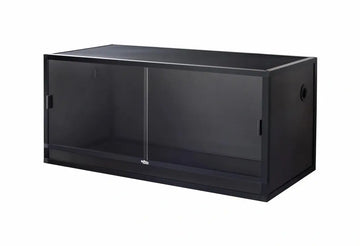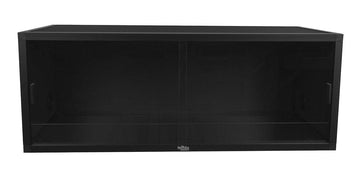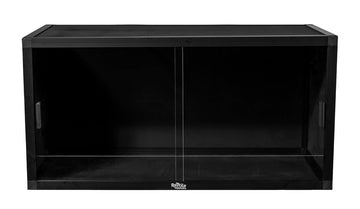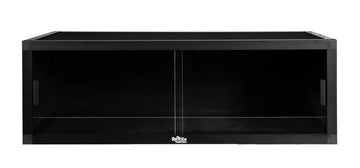Kenyan sand boas (Eryx colubrinus) are 18-36” long, nocturnal, fossorial snakes native to northern and eastern Africa. They prefer areas of loose, sandy soil with rock cover and low vegetation for habitat.
Kenyan sand boas have a thick, wormlike body with a blunt tail, small head, and eyes placed more on top of their skull than on the sides. They are covered in small, smooth scales, except for the tail, which has larger, rougher scales to assist burrowing. They typically have a pattern of dark brown/black spots on an orange background, with a pale belly.
Kenyan sand boas are popular pet snakes due to their manageable size, docile nature, slow movement, and ease of keeping. With good care, they can live up to 30 years.
Minimum terrarium size for Kenyan sand boas
Adult males tend to be much smaller than adult females, so the minimum enclosure size requirements are actually different for each:
- Male — 30”L x 12”W x 12”H (20 gallon long)
- Female — 36”L x 18”W x 18”H (40 gallon breeder)
If you do not know your snake’s sex, it’s best to go for the larger enclosure rather than smaller as a precaution. Juveniles can be housed in adult-sized enclosures, so there is no need to spend extra money on intermediary enclosures and their accessories.
Cohabitation (keeping multiple Kenyan sand boas in one enclosure) is not recommended, as these snakes are not a social species, and keeping them together causes unnecessary stress.
Do Kenyan sand boas need UVB?
Technically they can survive without it, but we still recommend providing appropriate UVB lighting to Kenyan sand boas. UVB lighting helps provide a clear day/night cycle, provides all of the vitamin D that your pet needs, strengthens the immune system, facilitates better digestion, and other benefits.
Kenyan sand boas do best with low-strength UVB as part of their enclosure. The best UVB bulbs for Kenyan sand boas vary based on the size of the enclosure:
- 30” long, 12” tall — T8 Zoo Med Reptisun 10.0, 18”
- 36” long, 18” tall — T5 HO Arcadia 6%, 22” or T5 HO Zoo Med Reptisun 5.0, 22”
For best results, house the UVB bulbs in a reflective fixture. Position the lamp on the same side of the terrarium as the heat lamp. Don’t forget to replace your bulb every 12 months!
UVB is blocked by glass and plastic, so placing the terrarium in front of a window doesn’t count as “free UVB” — in fact it can make your terrarium too hot due to the greenhouse effect.
Lights should be on for about 12 hours/day. All lamps should be turned off at night.
Best temperature for Kenyan sand boas
Like other reptiles, Kenyan sand boas are cold-blooded, which means that they rely on external temperatures to manage their own body temperature and metabolism. A reptile’s enclosure should offer a range of temperatures to allow them to thermoregulate effectively.
Specifically speaking, Kenyan sand boas should have a basking surface temperature of 95°F and a cool side temperature between 72-80°F. Surface temperatures can be measured with an infrared thermometer, but air temperatures should be measured with a digital probe thermometer.
Provide heat for your snake with at least one halogen flood heat bulb. Do not use ceramic heat emitters (CHEs), heat mats, red bulbs, or blue bulbs, as these are not as effective. Heating should be turned off at night.
Best humidity levels for Kenyan sand boas
Although Kenyan sand boas are often thought of as arid, desert animals, they actually come from an area with surprisingly high humidity levels. Average air humidity in your sand boa’s enclosure should be between 60-80%, as measured by a digital probe hygrometer placed in the middle of the enclosure.
There should be a 1-2” layer of damp substrate below the rest of the (drier) substrate. This creates a humid retreat for your snake to use as needed. The easiest way to do this is to pour water directly into the substrate.
Best substrate for Kenyan sand boas
As a fossorial (burrowing) species, Kenyan sand boas do best when they have a thick, 6” layer of sandy substrate in their enclosure. Aside from helping maintain healthy humidity levels and facilitating natural behavior, it will also help make your enclosure more attractive!
We recommend the following substrates for Kenyan sand boas:
Substrate should be completely replaced every 3-4 months. Remove poop and urates daily, along with contaminated substrate.
How to decorate a Kenyan sand boa terrarium
An empty terrarium makes for a bored sand boa, reducing its quality of life. Keep your pet entertained and engaged with its environment with the strategic use of décor items that encourage it to exercise natural behaviors!
Since Kenyan sand boas are fossorial, many people think that decor items are a waste of money. Not so! They love to climb low branches and explore anything that they are given, as long as they feel secure. Here are some ways to enrich your sand boa’s terrarium:
What to feed to a Kenyan sand boa
Kenyan sand boas are carnivorous, which means that they need to eat whole animal prey in order to get the right nutrition. Here is a basic feeding schedule:
- Babies — 1 pinky mouse every 5-7 days
- Juveniles — 1 fuzzy mouse every 1-2 weeks
- Adult males — 1 hopper mouse every 2-4 weeks
- Adult females — 1 small adult mouse every 2-4 weeks
- Large adult females — 1 medium adult mouse every 2-4 weeks
Prey items should be around 10% of the snake’s weight and roughly the same width. Prey should be thawed in a BPA-free plastic bag in warm water until it reaches ~100°F, then use a pair of soft-tipped feeding tweezers to offer it to your snake. To reduce the chances of excess substrate ingestion, use a paper plate.
One of the keys to great nutrition is variety, so aside from offering mice, you can also try young rats, button quail, and even small lizards.
Young juveniles may refuse to eat pre-killed prey. If that is the case, you will need to use live until you can convert them to frozen-thawed.
Supplements
Kenyan sand boas can survive without supplementation, but using them every once in a while can help prevent your snake from developing a nutritional deficiency, helping it live healthier. We recommend Repashy Calcium Plus LoD, lightly dusted on the prey item before offering.
Water
Of course, don’t forget a water bowl for your snake to drink from and soak in! Change the water daily and scrub the bowl with a reptile-safe disinfectant weekly, or whenever it becomes soiled.
How to handle your Kenyan sand boa
Reptiles generally don’t appreciate petting and handling in the same way that dogs and cats do. That being said, Kenyan sand boas generally tolerate human interaction pretty well! When picking up your sand boa, be gentle and try to pick it up from the side or below rather than from above. Support as much of its body as possible, and NEVER pick it up by its tail, as this can damage its spine!
*This care sheet contains only very basic information. Although it’s a good introduction, please further your research with high-quality sources. The more you know, the better you will be able to care for your pet!











